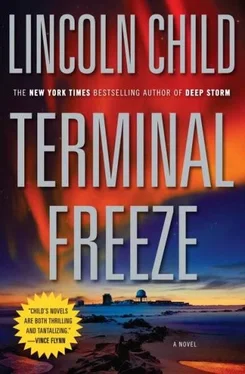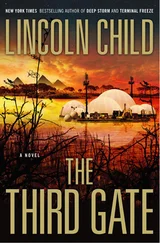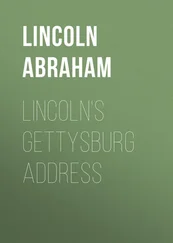“I’ll be quick,” Logan replied.
Hunt frowned, nodded. Then, turning the key, he pulled open the door. Air rushed out from the blackness beyond-stale air, dust-laden. The very smell quickened Logan ’s pulse.
The Omega Archive was precisely the kind of find that Jeremy Logan-for whom the title of medieval scholar was something of a genteel, if accurate, smoke screen-lived for. In the years following the Second World War, the government had taken advantage of the built-in security of the congressional bunker to store secret and top-secret military records. Though the bunker itself had been declassified a decade earlier, it had taken many more years-and much political pressure from historians, journalists, and freedom-of-information advocates-to clear away the red tape surrounding the Omega Archive. And while technically the archive had been declassified as of this morning, standard procedure was for representatives from the security agencies to examine its files-and in the process remove many still deemed sensitive-before allowing general public access. Logan had called in several favors in order to gain brief access before this final vetting process began.
The space he stepped into was utterly black, but some sixth sense told him it was large-very large. He felt along the wall, found a bank of at least two dozen light switches, and snapped a few on at random.
With a low boom, rows of fluorescents began flickering into life here and there ahead of him, creating small pools of yellow in a sea of darkness. He switched on additional lights and, finally, the entire archive came into view: row after row after row of ten-foot-tall olive-green cabinets arranged in regular columns, marching back almost out of sight. He stood in the doorway, blinking, gradually accustoming himself to the scale. The space before him was wider than a football field and at least as long. His eye traveled over the banks of files. The amount of potentially fascinating information stored in here-official secrets, scientific pa tents, confiscated cultural and national patrimony, sets of sworn testimony whose contradictions would prove most enlightening-could keep him happily occupied for years.
A restless movement beside him reminded Logan he was working on borrowed time. With a smile and a nod, he took a fresh grip on his briefcase and strode forward. The file that interested him in particular concerned an event that took place in Italy in 1944. While fighting the Germans for control of Cassino, units of the American Fifth Army commandeered an ancient fortress-the Castello Diavilous. The long-deserted castle had once been home to an infamous alchemist who performed extremely unsettling experiments. Following the occupation, the castle was burned to the ground, its secret basement laboratory ransacked. Logan had been tracking the alchemist’s accomplishments and the fate of his bizarre experiments. His best hope to learn more, he now knew, was here, among the moldering files of the Omega Archive.
He proceeded briskly down the tall metal ranks, peering at the labels on the cabinets at random. He quickly determined they were chronological, further subdivided by armed services branch. It was the work of ten minutes to locate 1944; five more to bracket the files related to the Fifth Army; another sixty seconds to pinpoint dossiers related to the Italian theater of operations. He pulled the appropriate drawer to its maximum. There were perhaps three feet worth of manila-and khaki-colored files related to operations at Cassino. They were dusty and badly faded, but otherwise appeared to be barely touched. A quick flip through the titles located a thick file labeled “ Fort Diavilous -Tactical and Strategic.”
He glanced over at Hunt, who was standing nearby, looking on like a disapproving chaperone. “Is there a reading table nearby I can use for my examination?”
Hunt blinked, sniffed. “The commissary is down the hall past the electrical substation,” he said. “I’ll take you there.”
Logan pulled out the file, prepared to close the drawer. Then he stopped. Removing the file had exposed another behind it, almost equally faded. Its title tab had been stamped with a single word: “Fear.”
Instinctively, Logan reached for it, pulled it forward. It was very thin. Behind it lay another file, identical, stamped with the same word.
Both copies of a classified file, stored in the same location? Something was very wrong here.
He shot a hooded glance toward Hunt. The man was walking down the aisle of hulking cabinets, his back to Logan. Looking back at the drawer, Logan cracked open the first of the two identical files, scanned the cover sheet.
TOP SECRET
United States Army

REFERENCE
B2837(a)
Logan ’s instincts as a researcher into the abnormal were finely tuned, and now they were going off full blast. This was an opportunity, and he didn’t hesitate. As stealthily as possible, he snapped open his briefcase; slipped one of the two thin folders beneath other paperwork; closed the case again; placed the Castello Diavilous folder atop the black leather. And then, closing the file drawer and arranging his face into an expressionless mask, he turned and followed Hunt, the view facilitator, out of the echoing vault and down the concrete hallway.
Within five days, Fear Base was transformed utterly. The three-acre apron of concrete between the base entrance and the perimeter fence had become a frantic anthill of activity. Helicopters and small transport planes arrived day and night, dropping off workers, supplies, food, fuel, and all manner of exotic equipment. The quiet, dimly lit hallways of the base’s central wing now seemed like city boulevards: full of chatter, the clacking of keyboards, and the whir of machinery. Power cables snaked everywhere, waiting treacherously to trip the unwary. The base’s powerhouse, until now operating at near-minimum capacity, had been ramped up to 50 percent, filling the arctic silence with its growl. Sergeant Gonzalez and his three army engineers had seemed first astounded, then annoyed by this sudden invasion that turned their once-somnolent base into a hive of demanding, high-maintenance urbanites. The small team was at work night and day, splicing broken wires, fixing leaks, opening heating ducts, and in general making several dozen rooms-largely unused for fifty years-habitable once again.
Evan Marshall walked down the mountain valley, a cooler full of specimens on one shoulder. Halfway to the base, he stopped briefly to rest and survey the small city below, bathed in early-afternoon sunlight. Although the documentary team was naturally bunking in the warmth of the base-various quarters on B Level for the grips, gaffers, publicists, and production assistants, and fancier officers’ compartments on C Level for the producer, director of photography, and channel rep-there were still plenty of outbuildings cluttering the grounds. He could make out a variety of prefab huts, storage shacks, and other temporary structures. At one side, a hulking Sno-Cat-an all-terrain vehicle with massive, tanklike treads-guarded a gasoline depot that would do an army division proud. And beyond everything else, standing alone just within the fence, was a metal-walled cube: a mysterious vault about which the scientists had been able to learn nothing.
With that morning’s arrival of Emilio Conti, the executive producer and creative force behind the project, the breakneck pace had accelerated still further. Conti had hit the ground running. At his order, large machines now effectively blocked the top of the glacial valley, complicating the scientists’ access to their work site. From what Marshall had heard, the producer spent his first hours on-site walking around the base and the surrounding permafrost with his photographic team; studying the way the light fell on the snow, the lava, the glacier; scrutinizing everything through a dozen different positions with a wide-angle lens that hung around his neck. Kari Ekberg had been with him the entire time, filling him in on what she’d accomplished, getting him up to speed, jotting down his work orders for the days to come.
Читать дальше













